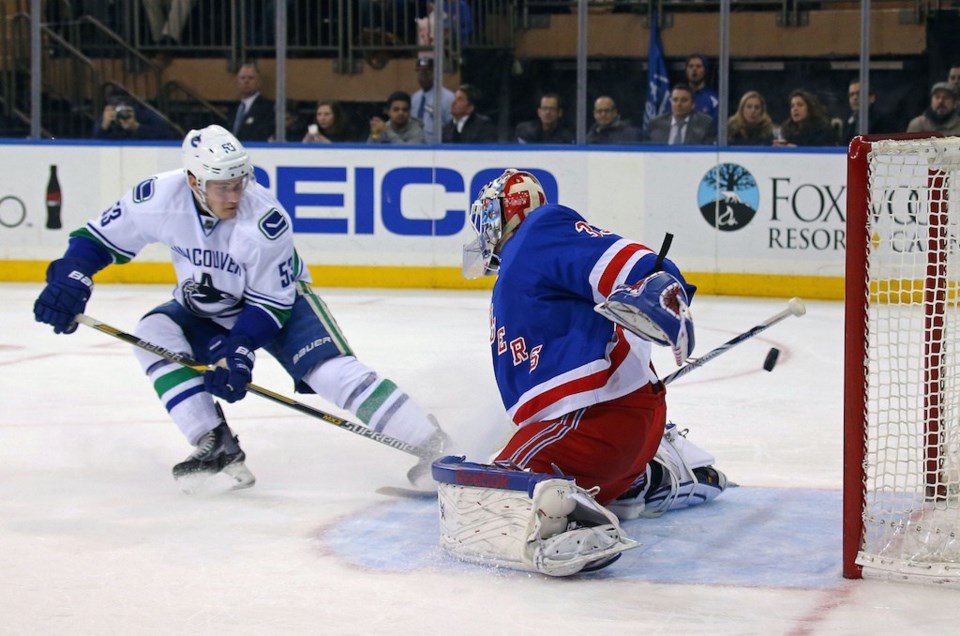Below you will find a compendium of interesting stats. Take from them what you will. Or, if you're feeling particularly sluggish, take from them what I have taken from them. Whatever.
1 - Coaches fired before Willie Desjardins, so far. I’m not necessarily saying that Desjardins should be fired, mind you, just noting that and has managed to avoid that fate. I doubt anyone had money on Gerard Gallant being the first coach fired, so a bunch of compulsive gamblers just tore up their metaphorical betting tickets and threw their metaphorical Trilby hats to the ground in frustration.
15 - The big number story in Â鶹´«Ã½Ó³»right now is Bo Horvat’s points, as he leads the Canucks in scoring with 15. It’s the first time in approximately forever that a non-Sedin has led the Canucks in scoring at this point in the season and it puts him on pace for 56 points, which is .
2.00 - At 5-on-5, Horvat is averaging 2.00 points per 60 minutes of ice time, which leads the Canucks. Right behind him is Sven Baertschi at 1.99 points per 60 minutes, which may come as a surprise, given that his season has been seen as disappointing so far. Horvat’s 2.00 points-per-60 is good for 65th in the NHL among forwards with at least 100 minutes played, again putting him just at the edge of first-line production.
21 - Bo Horvat’s age and also the number of minutes Troy Stecher is averaging per game, good for fourth among rookie defencemen. But when it comes to shots per game, Stecher is the clear leader, as pointed out by Corey Pronman:
Stecher is at 3.15 shots/gm for VAN, Werenski 2.80 for CBJ. Two rookie dmen cleared 2.50 in a full season in last 20 yrs (Subban, Phaneuf).
— (((Corey Pronman))) (@coreypronman)
3 - The Canucks may have nine wins this season, but just three of them have come in regulation. That’s the fewest in the league, fewer than even the lowly New York Islanders, who have just six wins total.
2 - After 22 games, the Canucks are two points out of last place in the Western Conference, with both teams behind them and both teams behind them, the Colorado Avalanche and Calgary Flames, have two games in hand. That said…
3 - ...the Canucks are just three points out of a playoff spot and they have a game in hand on the team in the second wild card spot, the Nashville Predators. This is partly because we’re still just a quarter of the way through the season, but also because of the parity in the West. Apart from the Coyotes, every team outside the top three in each division has 9 or 10 wins. At some point a couple teams in the middle of the pack are going to pull away from the basement dwellers, but for now the field is wide open.
-18 - Excluding the shootout, the Canucks’ goal differential is minus-18, which somehow isn’t the worst in the league. The Calgary Flames are minus-19 and are well on their way to missing the playoffs for the seventh time in eight seasons. I’m mostly just saying that to make myself feel better about the one time they did make the playoffs…
96.8 - Here’s where there’s some hope for the Canucks' goal differential woes: their PDO—the sum of their shooting percentage and save percentage at 5-on-5—is just 96.8, the lowest in the NHL. With a PDO that far below 100.0, we can safely suggest that the Canucks have been unlucky this season and should see an improvement in their goal differential. PDO regresses over the course of the season: the lowest PDO last season was 98.3 from Carolina and Toronto.
5.74 - The Canucks’ 5-on-5 shooting percentage of 5.74 is one culprit for their low PDO and even with their lack of snipers on the team, it’s likely to improve as the season progresses. Surprisingly, it’s not even the lowest in the league. The Sabres have scored on just 5.06% of their shots at 5-on-5. So the Canucks better hurry and acquire one of the Sabres’ snipers, right?
.911 - The Canucks’ shooting percentage stinks, but they’re also near the bottom in 5-on-5 save percentage, with only the Flyers and Maple Leafs posting worse numbers than the Canucks’ .911, which is a pretty bad number for many, many reasons.
.905 - You might think that Jacob Markstrom’s recent struggles—allowing 7 goals against the Rangers, then 4 against the Blackhawks before getting pulled—would be to blame for the Canucks’ low team save percentage, but his even-strength save percentage is .912. It’s Ryan Miller with the .905 save percentage bringing things down. Not that either number is good: Markstrom and Miller are 28th and 31st in even-strength save percentage among goalies with at least 10 games played.
.933 - Miller has been stellar on the penalty kill, however, posting a .933 save percentage when down a man, third best in the league behind Cams Ward and Talbot. The problem is that shorthanded save percentage generally isn’t sustainable long term. Miller posted an .868 shorthanded save percentage last season, so it’s reasonable to wonder if he might come crashing back down to earth before too long.
*statistics via nhl.com, stats.hockeyanalysis.com, corsica.hockey, and puckon.net
Ìý



